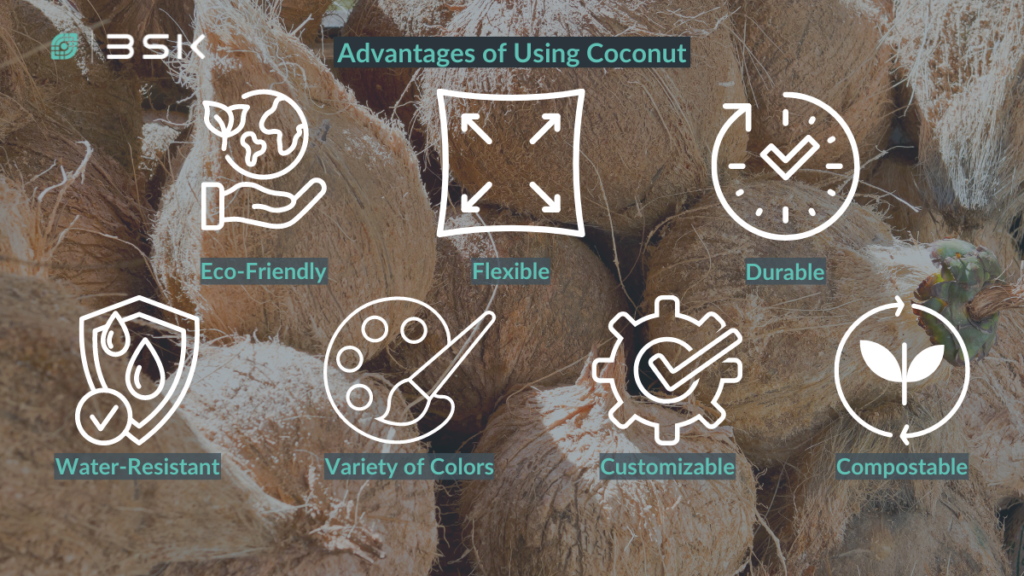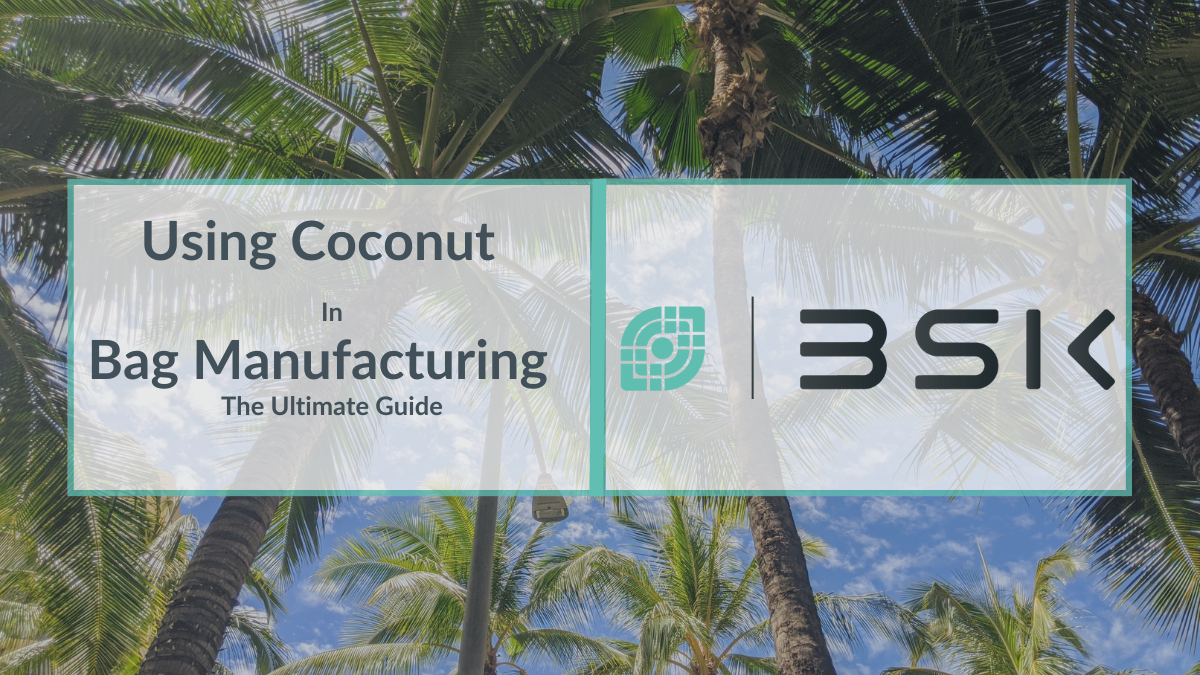Using coconut leather in bag manufacturing marks an incredible leap forward. This innovation benefits those in search of environmentally friendly and cruelty-free alternatives to traditional leather. This innovative material comes from the fibrous part of the coconut husk. It is not only sustainable but also a byproduct of the coconut industry, which people would otherwise discard. Its utilization in creating bags showcases a commitment to reducing waste and minimizing the environmental footprint associated with leather production. This approach offers consumers a durable, versatile, and ethical option for their fashion needs.
Definition & Overview of Coconut Leather
The material we’re covering is made from bacterial cellulose derived from the waste of coconut water. It turns something typically discarded into something incredibly useful. This isn’t your regular nylon, leather, or polyester. It’s a vegan alternative that’s got some neat qualities. It’s flexible, durable, and water-resistant, but also doesn’t trigger allergies, which is a big plus. People compare it to leather or paper because of how it feels and works, but it’s way more eco-friendly. They’re making bags out of it. You get something that’s not only stylish and sturdy but also kind to the planet.

Advantages of Using Coconut Leather in Bag Manufacturing
Coconut leather is a groundbreaking material that harnesses the natural properties of coconuts to create an eco-friendly alternative to traditional fabrics. This sustainable innovation benefits the environment and boasts remarkable characteristics, making it an ideal choice for fashioning a variety of items, including bags. Let’s explore the unique qualities that set coconut leather apart:
Eco-Friendly to the Core: The material is crafted from agricultural waste from the coconut industry. Instead of allowing this waste to accumulate and negatively impact the environment, it’s transformed into something both beautiful and useful. It’s completely organic and sustainable, making a bag made from coconut leather a statement of love for our planet.
Tough Yet Gentle: This material is both flexible and durable, capable of withstanding daily wear and tear without showing signs of age. It resembles leather but has none of the guilt as it’s 100% vegan. Whether in need of a sleek tote for work or a sturdy backpack for adventures, coconut leather offers an excellent choice.
Water-Resistant Wonder: A soggy bag is nobody’s friend. Fortunately, bags crafted from coconut leather are water-resistant. This means in the event of a drizzle or an accidental spill, your possessions remain safe and dry.
Colorful and Customizable: The allure of coconut leather extends beyond just one color. It’s available in a variety of colors, all naturally dyed, giving you the freedom to choose or even design a piece that truly reflects your personal style.
Eco-Chic Life Cycle: And for the finale – when a bag made from coconut leather has served its purpose, there’s no need to worry about it contributing to landfill waste. It can be composted right at home, completing its eco-friendly life cycle in the most stylish way possible.
Stylish Choice for the Eco-Conscious Fashionista
So, whether you’re a fashion-forward individual looking to make more ethical choices or someone who appreciates innovation and sustainability, bags made from coconut leather are a game-changer. They’re not just good for the environment but durable, stylish, and versatile enough for any occasion.
Limitations of Coconut Leather
Firstly, coconut leather, a newly developed material from bacterial cellulose, promises durability and a leather-like feel, which are great for bags. However, as with any natural material, the long-term durability compared to traditional leather or synthetic alternatives such as PU leather might vary, especially under different weather conditions or heavy usage. It’s flexible and water-resistant, but the extent of its resistance to wear and tear over time could be a concern for some users.
Cost-wise: Coconut leather is created from agricultural waste using a complex fermentation process, which may result in higher production costs compared to conventional materials. This could translate to more expensive end products that limit accessibility or appeal to a broader audience.
The scale of production: Coconut leather is notably positive, utilizing waste and offering a biodegradable end-of-life option. However, the scale of production and the efficiency of the process could pose challenges in truly offsetting the environmental footprint, especially if the demand for such eco-friendly materials skyrockets.
Maintenance of coconut: Due to its organic nature, maintenance of coconut leather-made bags might require more specific care than traditional materials. While it’s water-resistant, the extent to which it can be cleaned or exposed to various elements without damage could be a limitation for some users.
Getting around the limitations
A blend of coconut leather with other sustainable materials could help to overcome these potential limitations, enhance durability, and reduce costs. For instance, incorporating hemp or recycled polyester offers a balanced approach, improving strength and making the production process more cost-effective. Additionally, ongoing research into the treatment and finishing of coconut leather could further enhance its durability and maintenance profile, making it even more appealing for everyday use.
In essence, while coconut leather presents a fascinating and sustainable option for fashion-forward, eco-conscious consumers, being mindful of its care requirements and considering blended materials could pave the way for wider adoption in the fashion industry, especially in bag manufacturing.
Production & Manufacturing Considerations of Coconut Leather
Manufacturing Processes
The journey of creating sustainable materials often begins with unconventional sources, such as agricultural waste from the coconut industry. An interesting method allows for the transformation of this waste into bacterial cellulose, which is a sustainable and organic material. This material is not your average fabric; it is made from organic and sustainable bacterial cellulose, making it environmentally friendly and innovative. The cellulose transforms into a flexible, durable material resembling leather, with water resistance, and is completely vegan.
Special Equipment or Techniques
Coconut leather, being a unique material, may require specialized techniques for working with it. It is water-resistant and available in different thicknesses, so adjustments to the manufacturing process may be necessary to ensure its integrity during cutting and assembly.
Design, Cutting, Stitching, or Finishing Considerations
The material is creatively versatile, coming in sheets of varying thickness. Choosing from a variety of colors dyed naturally for this product. Designers must consider its flexibility and durability for optimal use. Cutting and stitching methods depend on the product, for bags, wallets, or notebooks.
In essence, coconut leather’s process is a beautiful blend of traditional craftsmanship and innovative material science, all while keeping sustainability and ethical practices at the heart of what they do. It’s not just about making something to use; it’s about adding value and purpose to what might otherwise be considered waste and doing so in a way that’s kind to the planet.
Sustainability & Environmental Impact
Coconut leather is a sustainable and eco-friendly innovation made from coconut water, which would otherwise contribute to pollution. Known as bacterial cellulose, it is environmentally friendly, vegan, durable, water-resistant, and hypoallergenic. Malai, the company behind this initiative Malai, works closely with South Indian coconut farmers to repurpose waste and create sustainable products. This approach aligns with current environmental concerns by promoting renewable resources and minimizing waste.
The bacterial cellulose material offers a viable alternative to animal-based products like leather, reducing waste and utilizing resources more efficiently. Additionally, the company aims to make the material affordable and practical, emphasizing sustainability and resource management. Overall, this innovation represents a significant step towards more sustainable living and provides a promising solution to environmental challenges.
Malai, the company behind coconut leather, is committed to ethical and sustainable practices in the fashion industry. It has earned prestigious certifications, including PETA-Approved Vegan and Cradle to Cradle Certified Material Health at the Gold level, highlighting its dedication to cruelty-free processes and environmental and human health. Other industry certifications, such as GOTS and OEKO-TEX certifications, could further solidify Malai’s standing, affirming the organic status of its materials and guaranteeing product safety.
Conclusion
Highlighting the innovative efforts of Malai, a company that collaborates with South Indian coconut farmers. This collaboration addresses the issue of coconut water waste. By processing this waste of coconut water, Malai produces bacterial cellulose. This material stands out for its flexibility, durability, and water resistance. It’s also non-allergenic, vegan, and comparable to leather or paper. This stands out, especially because people usually discard vast amounts of coconut husks and coconut water. This contributes to pollution and soil acidification. Malai’s initiative not only offers a sustainable alternative to this waste problem. It also contributes to the broader goals of sustainable material design.
The bacterial cellulose material produced by Malai offers numerous advantages. It is strong, flexible, and durable. Additionally, it is water-resistant, making it an excellent candidate for various applications, including as an alternative to leather. Its production is also environmentally friendly, helping to reduce waste and pollution. However, the limitations of this material primarily revolve around the challenge of scaling production. Additionally, justifying the cost compared to more conventional materials presents a potential issue.
For those in the bag manufacturing industry, this material presents an exciting opportunity. Its unique properties and sustainable credentials could cater to a growing market. Consumers are increasingly looking for eco-friendly alternatives to traditional materials. Manufacturers should consider this material’s suitability for their production needs, especially if they aim to appeal to environmentally conscious consumers. Embracing such innovative materials can not only enhance a brand’s sustainability profile but also potentially open up new market opportunities.
